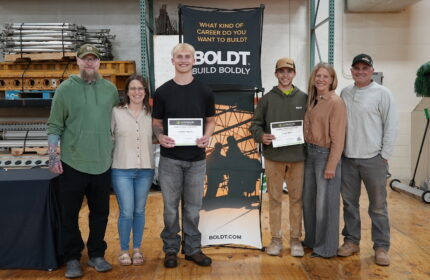Media
CEM Alum Takes Bold Approach to Massive Hospital Project
Release Date: 08/03/2015 | UWMadison, WI College of Engineering
David Thomack recently had the pleasure of changing his grad-school professor’s mind about a controversial idea in the construction business.
Thomack earned his bachelor’s degree from the University of Wisconsin-Madison in civil and environmental engineering in 1994 and his master’s degree in 1996 from the department’s Construction Engineering and Management (CEM) program. He is leading the construction of the Sutter Health/California Pacific Medical Center’s new campus in downtown San Francisco for HerreroBoldt, a partnership between Herrero Builders Inc. and Wisconsin-based construction firm The Boldt Company. The $2 billion, 700,000 square-foot hospital will occupy an entire city block and it is the largest project in the United States to execute Sutter Health’s vision for Integrated Project Delivery (IPD). The technique aims to streamline construction and increase worker productivity by breaking down communication barriers among all the different partners in a project, heading off some of the big decision-making bottlenecks that can happen in construction.
“We’re eliminating the constraints that would generally be barriers to us building the project at the speed we would like to,” Thomack says. “Instead of us working in silos where we pass information over walls, we put the players together and engage in the same conversation. It allows us still to think as individuals, and also to problem-solve as a group.”
But Civil and Environmental Engineering Professor and CEM chair Awad Hanna has seen a lot, and when he visited Thomack at the medical center construction site in early 2015, he was not yet a believer in Integrated Project Delivery. When he saw the work in action, though, Hanna realized Thomack was successfully enacting many of the innovative ideas the CEM program researches and teaches.
“I’ve seen a lot of very impressive construction projects all over the world, but I was impressed by the advanced management techniques I saw at this job.” Hanna says.
One key to Integrated Project Delivery on Sutter projects, and on the projects where Boldt has implemented its own trademarked Integrated Lean Project Delivery® (ILPD) system, is that representatives from not just the general contractor (in this case HerreroBoldt), but also the designer (SmithGroupJJR) and the project’s owner, Sutter Health/CPMC, along with all of the project trade partners, design partners and subcontractors, are based at the actual worksite and put their heads together on a daily basis. That model—the “integrated” part—pervades every step of the process. For instance, during summer 2015, workers have been installing structural steel for the new hospital. In a conventionally managed construction project, a structural engineer, a general contractor and a steel supply and erection company would pass plans back and forth through multiple rounds of revisions and approvals. ILPD tries to get all those people on the same page from the start.
“In our case here, we’re all working together,” Thomack says. “The building is being designed by the structural engineering firm and the steel supplier and installer. They’re all working together to make sure what they design can be built and there aren’t multiple sets of documents. There’s one fully integrated electronic model.”
These streamlined workflows mean a high level of predictability of scope, budget and schedule for Sutter Health, less uncertainty and wasted time for workers and mutual accountability for all the companies and trades involved in a massive, sophisticated project. Another key feature of IPD at Sutter and of the ILPD system at Boldt is that the general contractor, designer and customer—and often subcontractors as well—all enter into one contract, instead of the customer signing separate contracts with each of these different partners. This isn’t just significant on paper. It means that everyone involved has a mutual stake in the project’s success, sharing in the risks and rewards.
“It’s faster, delivers higher quality and is less contentious than a standard project,” Thomack says. “Each one of our ILPD projects is highly successful, and we see it gaining traction in the industry.”
In fact, Hanna has asked Thomack and a group of Boldt experts, led by The Boldt Company’s Western Operations President Dave Kievet, to return to the campus in the spring of 2016 to teach ILPD concepts to graduate students. The course will be just the latest in a long history of mutually beneficial collaborations between CEM and The Boldt Company, whose chairman, Oscar C. Boldt, earned his UW-Madison bachelor’s degree in civil engineering in 1948. The company is a major donor to the program and just as importantly, Boldt and CEM researchers have shared expertise and data on a number of real-world construction projects and award-winning academic research endeavors.
“They help us in teaching, they help us in research and our own graduates are really producing for the company,” Hanna says. “It’s a good cycle.”
For his part, Thomack has taken great pride in making a case for ILPD in California, but is also looking forward to reconnecting with the CEM program in Madison in 2016.
“The university has been a great friend to me,” Thomack says. “It’s taught me a lot through my internships, coursework and the leadership of the civil engineering department and I’ll give back any way I can for the rest of my life.”


